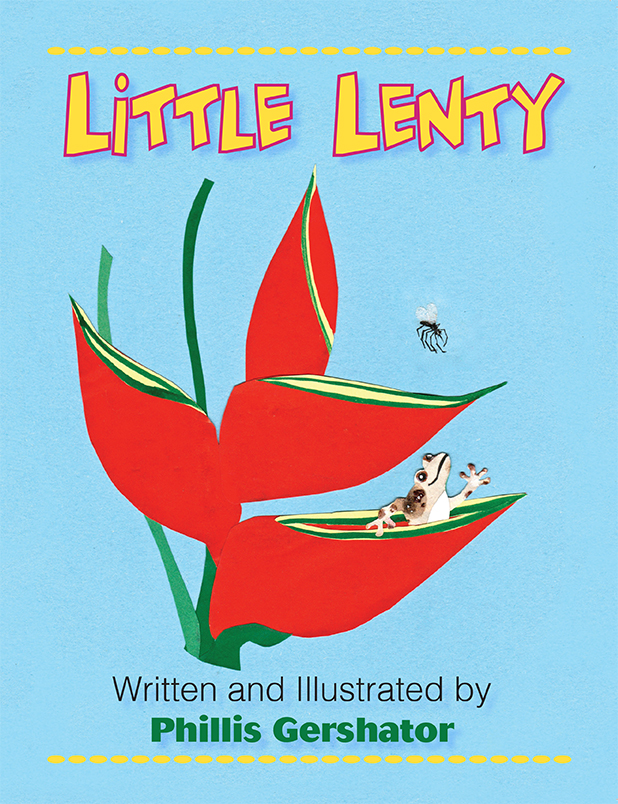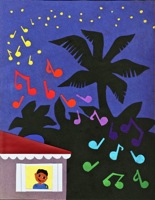|
|
|

|
LiTTLE
LENTY
written
and
illustrated
by
Phillis
Gershator
Campanita
Books
Little
Bell
Caribbean,
2014, 2019
|
*
Governor
Bryan's Virgin
Islands Summer
Reading
Challenge
2019.
From
the book jacket: |
In the Caribbean, all the frogs
sing, all except one. Heʼs a tiny
frog with a long name, Eleutherodactylus
lentus, and he lives in the
Virgin Islands. Lenty canʼt sing
like the other frogs, no matter how
hard he tries. But when Señor
Coquí shows up and leads the little
frogs in song, Lenty discovers there
is something he can do.
|
| A little about
the book: |
When I read William P. MacLean's Reptiles
and Amphibians of the Virgin
Islands (Macmillan, 1982),
I was especially intrigued by
his description of a voiceless frog
called Lentus. Lentus is a member of
the Eleutherodactylus family, tiny
frogs who lay eggs which hatch into
fly-sized froglets instead of
tadpoles.
I wondered, how
does a frog like Lentus communicate
with other frogs? People who
can't speak use sign language. The
idea came to me that even if Lentus
couldn't sing like other frogs, he
might well hop and leap and jump
better than they do. Maybe he could
even...dance!
In this book, I
wanted to illustrate not only our
local frogs, but other creatures who
live in the Virgin Islands, such as
the donkey, goat, green iguana,
morrocoy turtle, frigate bird,
pelican, hummingbird, green parrot,
bat, anoli lizard, land crab, egret,
mongoose, and frangipani hawkmoth
caterpillar. The Caribbean is also
home to beautiful and unusual
plants, including the flowers,
bushes, and trees pictured in the
book: fern, ginger, anthurium,
yellow alamanda, devil's backbone,
candlebush, orchid, airplant,
pineapple, frangipani, coconut palm,
sea grape tree, coleus, snake
plant, bromeliad,
croton, philodendron, bougainvillea,
and hibiscus.
Writing Little
Lenty was a way for me to
celebrate Bill MacLean's life. Bill
was a noted and enthusiastic
biologist and long time professor
at the University of
the Virgin Islands, as well as
a person of vast knowledge and
expertise in many diverse fields, a
true polymath, and a great
inspiration to me, just as he was to
all his students. I
hope this book, dedicated to Bill,
will also inspire the students who
join our Governor's Summer Reading
Challenge––and students everywhere!
|
| Things to do: |
1) There are
lots more animals and plants in the
Virgin Islands than you'll see in Little
Lenty. Can you draw some of
them? What about snakes, termites,
sugar birds, hawks, black anis, reef
fish, herons, doves, geckos.... What
about the century plant, monkey
puzzle, banana, lime tree, barrel
cactus, sea oat, papaya, love leaf,
flamboyant, yellow cedar....
Did I forget any?
2) Did you ever go on a frog hunt?
Keep a look out for frogs in damp
places, flower pots, plants that
hold water in their leaves. I've
seen frogs under the overhang of our
house, in our cistern, and once I
found a coquí in an open bag of
potting soil. Here
it is, life size, smaller than a
bougainvillea leaf!
After a rain, you might find puddles
on the roadside filled with
tadpoles.
(Eleutherodactylus
eggs hatch into froglets,
but other kinds of frogs' eggs hatch
into tadpoles. Day by day their
bodies change so they can live on
land as well as water.)
3) Find books in the library
about fictional frogs.
Some of my favorites are:
ALL of the Frog and Toad
books by Arnold Lobel
A Boy, a Dog, and a Frog by
Mercer Mayer
Frog Went A-Courtin' by John
Langstaff and Feodor Rojankovsky
Jump, Frog, Jump! by Robert
Kalan
And don't forget the most famous
frog fairy tale of all time:
The Frog Prince.
Please send me the titles of
your favorites and I'll add them to
this list.
4) Read non-fiction (true)
stories and books about frogs, about
their life cycles and how different
frogs have adapted to their
environment in different parts of
the world.
Click on this picture to read a
true story I wrote about the coquí
for Ladybug magazine
(April 2013).
5) Listen to the coquí's call:
http://search.yahoo.com/search?ei=utf-8&fr=aaplw&p=coqui
6) Watch videos about unusual
frogs.
Here are two short videos from
National Geographic:
The water holding frog:
http://video.nationalgeographic.com/video/animals/amphibians-animals/frogs-and-toads/frog_waterholding/
The "shaking" red-eyed tree frog:
http://video.nationalgeographic.com/video/news/red-eyed-tree-frogs-shaking-vin?source=relatedvideo
7) Make an origami frog:
https://www.youtube.com/watch?v=2p4SyN8Y8Is
|
Things to think
about:
|
Why do frogs make
noise? Mostly to defend one's
territory and to attract a mate.
Some frogs make noise before or
after rainy weather. Some cry when
they are hurt or in trouble. Some make
such high pitched sounds human
beings can't hear them. And some
cannot croak at all.
If a frog can't
make a sound, what might it do to
defend its territory or attract a
mate?
When the frogs in
Little Lenty taunt Lenty
because he can't make a sound, the
big frog doesn't join in. He tries
to teach Lenty to sing instead.
Why do people
taunt and tease one another? What's
the difference between taunting and
teasing?
Is teasing
ever funny? Affectionate? Bullying?
Mean? Does the person being teased
feel embarrassed? Amused? Hurt?
Happy?
Lenty isn't able to copy the other
frogs, and the other frogs can't
copy Coquí. Sometimes it IS
possible to copy someone else. Is
it a good thing to do? Or a bad
thing? Is so, when? Why?
Lenty joins the musical fun in his
own special way. He dances. Are
there other ways to show how much
we enjoy music?
We
have five senses:
sight, touch, taste, smell, hearing.
If one of our senses doesn't work,
can we use another in its place?
Would you rather
sing alone (solo) or in a chorus? Is
there a difference?

|
Frogs
singing at night––
under the starriest of stars
on the greenest of islands!
|
|
|
|
|
|